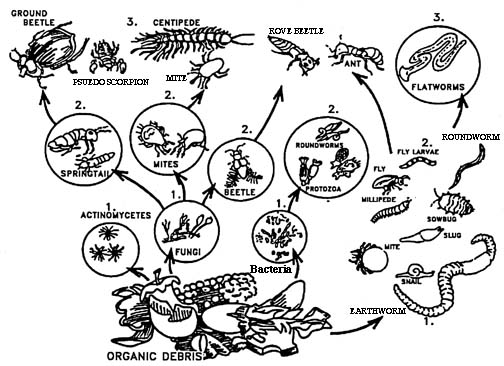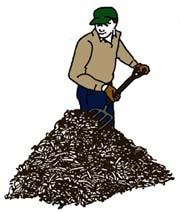Decomposition refers to the natural process of plant and animal tissue being broken down. This is an important process in any given ecosystem. This process is gradual and complex, involving both chemical and biological processes. Decomposition has been occurring since the first sight of life and will continue as long as life exists.
Recently, man has attempted to control and utilize the decomposition process; for instance, organic matter such as animal manure and vegetable matter can be converted into stable forms used in farming to boost productivity. This process is called composting, whereby two processes yield compost:
- Anaerobic decomposition (without oxygen)
- Aerobic decomposition (with oxygen)
In these processes, fungi, protozoa, bacteria, and other saprophytic organisms break organic matter initially and in later stages, millipedes, mites and springtails further breakdown compositing matter while enriching it too. There is a variation of organisms due to temperature conditions.

Anaerobic Decomposition (Fermentation).
This is the type of decomposition that takes place at the bottom of marshes and in buried organic matter where there is no oxygen access. Through putrefaction, organic matter is reduced, which is accompanied by odors of hydrogen sulfide and organic compounds of sulfur, e.g.,mercaptans; all organic compounds containing sulfur.
Fermentation is carried out by organisms that do not require oxygen. The organisms, therefore, use phosphorus, nitrogen, and other nutrients to survive. Aerobic destruction is a reduction process. Therefore, humus undergoes oxidation when exposed to air. This process is minor and happens rapidly; thus, heat generation is significantly lower than the heat produced in aerobic decomposition, which is a disadvantage if the compost contains contaminated material. This process is not favored by homeowners practicing agriculture due to the strong odor that is released.
Aerobic Decomposition.
This process is called aerobic because it takes place in oxygen presence. It occurs in places such as ground surfaces of forest floors. With adequate oxygen, there is no accompanying bad smell.

In aerobic decomposition, living things using oxygen feed upon the organic materials using phosphorus, nitrogen, and available nutrients. Carbon acts as a source of energy where it is burnt to produce C02. Biological activities diminish in case the carbon over nitrogen ratio is too great, thus, requiring several cycles f organisms to burn most of the carbon. However, when there is a sufficient balance of carbon to nitrogen, nitrogen is released in the form of ammonia.
Requirements for Efficient Decomposition.
Efficient decomposition takes place if moisture, aeration, particle size and a sufficient source of nitrogen and carbon are in available.
- Oxygen: Organic wastes are decomposed efficiently when oxygen is available. Decomposition in the absence of oxygen is slow and accompanied by a bad smell, which is not advisable in residential areas. Mixing the pile of decomposing material helps aerate it, thus speeding up the process.
- Moisture: The microbial activity requires adequate moisture, which encourages the growth of micro-organisms that break down organic materials into humus. In case of insufficient rain, it is advisable to water the pile periodically.
- Temperature: Low outside temperature hampers the activity while warmer temperatures speed it up. Microbes used fall into; mesophilic (live and function in temperatures of 50 to 113°F) and thermophilic (function in temperatures of 113 to 158°F).
- Particle size: The smaller the size of decomposing matter, the faster the process of decomposition.